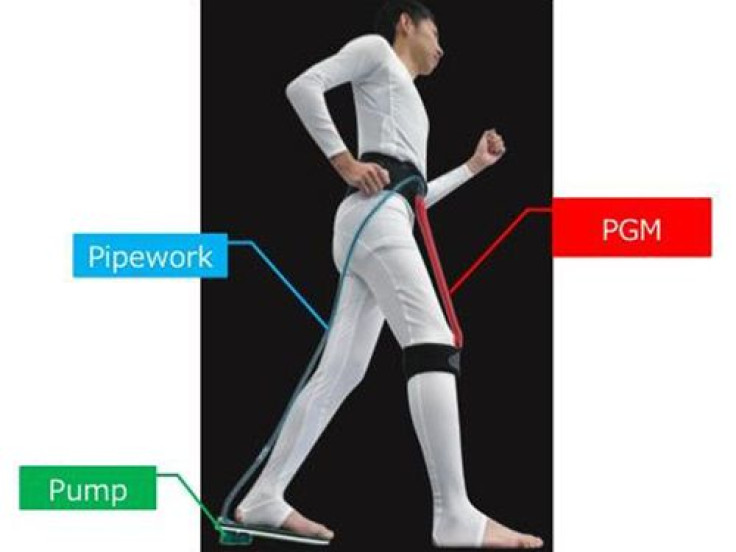Unplugged Power Suit Uses Pneumatic Artificial Muscle To Help Athletes Run Faster And The Elderly Walk Easier

Power suits in video games like Halo or movies like Edge of Tomorrow show huge, hulking suits that essentially turn their user into Superman. Unfortunately, those power suits are science fiction. In reality, most exoskeletons are bulky and cumbersome, as they’d need to get their energy from large batteries and motors. Moving one step closer to a leaner suit, researchers from Hiroshima University have now developed a new type of power suit that utilizes the user’s own weight for energy.
Developed in conjunction with Japanese medical manufacturer Daiya Industry, researchers will put the lightweight, incredibly efficient, and mobile device, called the Unplugged Powered Suit (UPS), on display this week at the International Robot Exhibition 2015. It’s purpose, however, is different from those you’d see in movies or video games — it’ll be used to help prevent injuries in the elderly and improve muscle performance in athletes instead.
"The UPS is designed to support human motion where and when needed,” said Dr. Yuichi Kurita, associate professor at Hiroshima University, in a press release. ”[W]e can customize the UPS to the user's particular needs, such as muscle strength for athletes and rehabilitation. In the future, we can develop smarter assistive suits including wearable actuators and sensors by using our technique."
The UPS gets its power from a pump located in the sole of the user’s shoe. When the user steps down, “ the air pressure is filled into the [ Pneumatic Artificial Muscle (PAM)] ,” Kurita told Medical Daily in an email. This causes the artificial muscle to shorten, which in turn generates “contractile force.” When PAM is placed on the right hip and the pump is placed on the left foot, it can also support hip movement during the leg-swing phase. In simpler terms, Kurita said the UPS takes “the generated force by the artificial muscle, [and] unloads the user’s muscle activity during motions,” which makes it easier for them to move.
Kurita and his colleagues gave a few scenarios in which the UPS would beneficial. He suggested it could increase running speed, for example. Placing the pump on a runner’s left foot and the PAM on their left calf would allow air pressure to pump into the PAM, which pulls the runners leg up quicker, allowing for a faster jogging pace.
Another example, meanwhile, related to increasing a pitcher’s throwing speed in baseball. The pump would be placed underneath the leg that moves forward when throwing, while the PAM would be placed on the pectoral muscle on the side of the body where the throwing arm is. When the pitcher steps down on the pump to deliver the pitch, the PAM pulls his arm forward faster, increasing the speed he throws.
Kurita said the UPS can also be used in other ways to help “ unload muscle effort during physical tasks, such as lifting up an object and standing up from a chair.” However, the quality of the UPS to last long needs to be improved first, he said. “ The wearability should also be improved. We are exploring the applications to use the UPS to enhance the experiences in sports, fitness, and training.”
As for when it will be released to the public, Kurita says they are aiming for 2020, with a price point of a few hundred dollars.



























